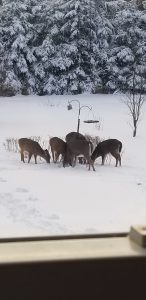Life is Hard
This is a story about deer. But it doesn’t begin like that.
Long ago, I was visiting my teacher son Morgan’s grade two class, setting up a weaving exhibit for the children on the tables at the back of the room. Meanwhile, on the rug at the front of the class he had his little ones sitting in a circle around his chair While I unfolded my portable loom at the back of the room,. Their attention was rapt while he was reading beloved Laura Ingalls Wilder to them. “‘Life is hard,’ said Ma,”.
Morgan raised his eyes, paused, and looked intently at the children, making a point. “Life’s hard. Is that true?” To my surprise, they all looked back at him seriously. “Yes.” Even at that age they knew that. Minutes later, though, they were engaged in a funny part of the story, were surreptitiously punching each other, were bursting out of class for recess. And yet, they knew this truth.
So, life is hard. It is. And like Morgan’s Grade Two’s we know that. It is also shiny with miracles, but that’s for another day.
Here at Singing Meadow there are so many stories to be read.
 The last few years in this area there have been too many deer. In general, I am not a friend of the eight deer who stroll over here several times a day. Last year, as the summer drought worsened, two mothers brought their twin fawns to rampage through my vegetable and flower gardens. The mother does were the largest I have seen, standing shoulder to shoulder with me and not inclined to back down in a confrontation.
The last few years in this area there have been too many deer. In general, I am not a friend of the eight deer who stroll over here several times a day. Last year, as the summer drought worsened, two mothers brought their twin fawns to rampage through my vegetable and flower gardens. The mother does were the largest I have seen, standing shoulder to shoulder with me and not inclined to back down in a confrontation.
This winter they have made my great pleasure of feeding birds sunflower seeds almost impossible. This year’s big boss doe is adept at butting the hanging feeders, tilting them until the seed spills on the ground. She doesn’t hesitate to kick the younger deer away, and there can be stamping and biting, with tufts of fur left behind.
I admit I have begrudged this herd, have muttered about how bad it is for the environment to have this excess, complained about local people who thought they were helping by feeding them. (I could also acknowledge that as a new settler here taking over their land I am part of the problem.)
But earlier this week the hardness of winter hit close to home. That morning there was an unfamiliar, wary-feeling quiet outside. None of the deer tribe came to interfere with the feeders, not the quiet yearling mother with her small fawn, not the solitary big doe, not the brash gang of five, of which the boss doe was the undisputed leader. Whenever I glanced outdoors chickadees and nuthatches and the three downie woodpeckers skipped back and forth, enjoying seed unhindered.
It wasn’t until early that afternoon that I caught sight of the smallest of the fawns rummaging through the piles of seed I leave on the ground for the tree sparrows and juncos, looking too shocked to care for itself, almost beyond being startled. And then I knew. Although I had not heard the drama, surely the previous night, illuminated by the full moon, coyotes had come running through the valley. Although I saw no tracks in the snow around the house, running along the road or up the ploughed laneways would have given them easy access. In the terror, the little one had been left to fend for itself. Where had the final circling enclosure, the gleeful frenzy taken place? I thought of nearby places where I had seen kills in other years.
It wasn’t long before the raven who travels between the table land and the frozen lake gave it away by her circling over the lake. She was far too busy and excited to pass directly over me in greeting, as she usually does. The herd surely must have been driven out onto the frozen lake. Possibly in the panic there had been a fatal slip on an ice patch.
Finally, at sunset five returned, stomping and hesitant. The fawn was back, glancing over her shoulder for someone who surely no longer was coming. So far the other deer were not willing to accept her into their tribe. But she hurried to move in as closely as she dared, likely knowing she will need the herd’s protection to survive.
I watch the remaining wary deer each day now. There is no more brashness. Every step is cautious. The innocence is gone.
The next month and a half will be the hard time. The culling time. Already the remaining deer bellies are swelling, while at the same time the ribs are beginning to show. Not jaunty any more, their walking is stiff and wary.
How easy it would be for me to drive to the feed store and pick up a bag of deer chop. How happy it would make me to be a benefactor, standing among the appreciative jostling. Only I know that coyote kills are quick and clean and that they are likely to devour the frail. In the long run, starvation from eating food they are not designed to digest is more cruel, as are the wasting diseases which are more likely to affect herds with overcrowding. All I can wish my own tribe is a sheltered ridge somewhere nearby, with lots of natural browse.